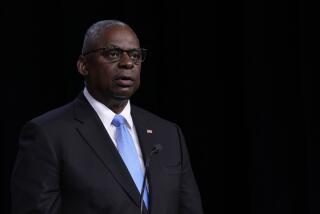U.S. and Saudis Detect Stepped-Up Iraqi Air Reconnaissance Along the Border : Surveillance: The increased flights indicate that Baghdad is taking the latest U.S. threats seriously.
- Share via
RIYADH, Saudi Arabia — Iraqi fighter planes have increased reconnaissance activity near the Saudi border in the last two weeks, indicating a heightened military alert against a possible U.S. strike, according to American and Saudi officials.
The stepped-up Iraqi missions, including high-speed charges toward the border, are regarded as a response to new bellicosity from the United States and as the clearest sign to date that Iraq is taking the American threats seriously, the officials said.
“They feel they’re under pressure,” Saudi air force Col. Abdul Rahman Bluwi said Wednesday in describing what he said is “some increase” in Iraqi activity monitored in round-the-clock surveillance missions by Saudi Arabia and the United States.
Other knowledgeable officials said the Iraqi upsurge marks a shift from a light pace of flight operations in the early months of the crisis to what they describe as a sometimes-heavy rate now, some of them from newly activated air bases in Iraq and Kuwait.
But Bluwi, the commander of Saudi AWACS early-warning radar surveillance aircraft, told the first reporters permitted to observe such a Saudi mission: “We know exactly what they’re doing.”
The increase in the Iraqi missions comes as the U.S. military begins what the commander of U.S. AWACS operations here described as a “tilt toward an offensive role.”
Meanwhile, Saudis and Americans both are increasing their emphasis on AWACS (airborne warning and control systems) aircraft that can coordinate a possible attack.
On a daylong mission over Saudi Arabia on Wednesday, a Saudi AWACS plane demonstrated what is the closest military coordination being conducted between the new allies.
The two countries’ systems are continuously airborne and are linked to produce a vivid radar picture of air traffic across the kingdom and deep into Iraq.
The windowless planes that serve as flying war rooms can look hundreds of miles into enemy territory. They provide a capability that has revolutionized aerial warfare from the days in which pilots had to rely on their own on-board radar.
The transformation, said Maj. Doug McMaster, an Air Force liaison officer flying aboard the Saudi plane, “is like you were in a dark room and then you turn on the lights and you see everything.”
Aboard the Saudi AWACS on Wednesday, weapons operators monitored half a dozen radar screens on the dome-crowned plane. They watched anxiously as an unidentified plane with military characteristics flew slowly in Jordanian airspace near Saudi Arabia.
Saudi officers said the route and behavior of the plane made them confident that the aircraft was from a friendly country. But in what is a tense atmosphere in the skies, they dispatched a pair of Saudi fighters to take a closer look at what turned out to be an incoming Omani transport plane.
In just an hour on post near the Saudi-Iraqi border, they kept close watch on at least five Iraqi aircraft, none of which ventured closer than 25 miles to Saudi Arabia. Later the AWACS coordinated a mock battle pitting Saudi F-15s against other fighters playing the role of incoming Iraqi “bandits.”
The aircraft worked throughout the flight in high-tech tandem with a U.S. AWACS plane to divide control of the crowded skies and keep a lookout to the north for possible attack. U.S. commanders praised the work as a “truly unified operation.”
Saudi Arabia purchased its own AWACS planes from the United States in 1981 in a $9-billion package that still stands as the largest arms sale in history. The sale was completed despite strong opposition from supporters of Israel. The AWACS aircraft were not delivered to the kingdom until 1986.
But the close bond between the two air forces was forged earlier. In the early 1980s, U.S. planes were stationed in Saudi Arabia to keep watch over the Persian Gulf during Iraq’s eight-year war with Iran.
Most Saudi AWACS officers trained in the United States, and officers from both services said the experience is paying dividends. Of about 10 AWACS in the combined fleet here, five are Saudi planes.
However, the Saudi aircraft are considerably less advanced than those now in the U.S. fleet. Designed to minimize the threat to Israel, they are suited principally for defensive operations and have not been modernized since their delivery four years ago.
In the current crisis, American commanders warned, those limited capabilities could restrict the role of the Saudi planes in managing any attack against Iraq. Americans fly aboard the Saudi AWACS during most missions here to make up for a lack of Saudi training.
The Americans said that combined training since the crisis began has improved Saudi tactics in “more aggressive” operations. But Bluwi, the Saudi commander, also indicated that more advanced AWACS technology might come to Saudi Arabia as a product of the current alliance against Iraq.
The colonel acknowledged that Saudi Arabia did not deploy its AWACS fleet on round-the-clock surveillance of Iraq until after the Aug. 2 invasion of Kuwait--despite the buildup of Iraqi forces that began weeks before.
More to Read
Sign up for Essential California
The most important California stories and recommendations in your inbox every morning.
You may occasionally receive promotional content from the Los Angeles Times.













